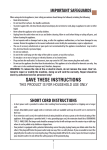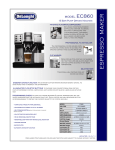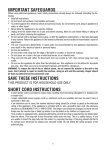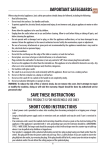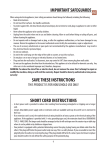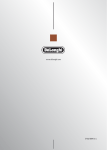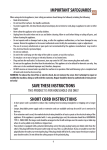Download De'Longhi Coffeemaker EC860 User's Manual
Transcript
5713218341/12.11 - Printed in China De’Longhi Appliances via Seitz, 47 31100 Treviso Italia Instructions for use coffee maker EC860 C C1 C2 CLEAN C3 C4 C5 D D2 D3 D1 D5 D6 D4 D7 D8 D9 2 D10 A A1 A14 B A5 A2 A6 A3 A4 A7 A13 A12 A11 A8 A10 A9 B B2 B8 B1 B7 B4 B10 B3 B9 B6 B12 B5 B11 3 17 OZ / 0.5 L 1 2 3 4 5 6 7 8 1 9 10 11 12 13 17 14 15 16 18 19 20 4 21 2 CLEAN 22 23 24 25 28 26 27 30 31 29 32 5 Safety warnings Symbols used in these instructions The important recommendations have these symbols. These warnings must be followed. Attention: Keep the packaging material (plastic bags, expanded polystyrene) out of the reach of children. Danger! Failure to comply can be or is the cause of injury due to lifethreatening electric shocks. Attention: Do not allow the appliance to be used by persons (including children) with reduced psycho-physical-sensorial capacities or that have insufficient experience and knowledge, unless they are carefully monitored and trained by a person responsible for their safety. Watch children, do not let them play with the appliance. Attention! Failure to comply can be or is cause of injury or damage to the appliance. Scalding hazard! Failure to comply can be or is the cause of scalding or burns. Scalding hazard! This appliance produces hot water and steam may form during operation. Pay attention not to come into contact with hot water sprays or steam. Do not touch the cup holder when the appliance is on because it can get. Please note: This symbol highlights recommendations and important information for the user. Fundamental warnings regarding safety Danger! As the appliance operates using electric current, electric shocks can not be excluded. Therefore, follow the safety recommendations given: • Do not touch the appliance when you have wet hands or feet. • Do not touch the plug with wet hands. • Make sure that the socket used can always be easily reached, so that the plug can be removed when required. • Remove the plug from the socket by pulling directly on the plug itself. Do not pull the cable as damage could be caused. • Remove the plug from the socket to disconnect the appliance completely. • Do not attempt to repair the appliance if it should breakdown. Switch the appliance off, remove the plug from the socket and contact the After-Sales Technical Assistance. • If the plug or power supply cable are damaged, have them replaced exclusively by the De’Longhi After-Sales Service, in order to avoid risks • During cleaning, never immerse the machine in water: it is an electric appliance. • Before performing any cleaning operations to the external parts of the appliance, switch the machine off, remove the plug from the socket and let the machine cool down. Complying with intended use This appliance is manufactured for the preparation of coffee and to heat beverages. This appliance is intended exclusively for domestic use. It is not intended for the use in: • rooms used as kitchens for personnel in shops, offices and other work areas • farm holidays • hotels, motels and other reception structures • guest houses Any other use must be considered improper and therefore dangerous. The manufacturer is not liable for damage deriving from improper use of the appliance. 6 Functioning lights en Lights Operation Meaning of lights Turn on from general ON/OFF switch, at the back of the appliance. The appliance performs a self-test, signalled by the sequential flashing of lights. The appliance is on: no accessory is connected to coupling A2. The appliance is heating up to make coffee: when the 1 or 2 cup lights stop flashing, the appliance has reached the ideal temperature to deliver coffee. The appliance is on: the hot water spout D7 is connected to coupling A2. The appliance is heating up to make coffee or to deliver hot water: when the 1 or 2 cup lights and the hot water spout light stop flashing, the appliance has reached the ideal temperature to deliver coffee or hot water. The appliance is on: the milk container C is connected to coupling A2. The appliance is heating up to make coffee, cappuccino or latte macchiato: when the 1 or 2 cup lights, the cappuccino and latte macchiato lights stop flashing, the appliance has reached ideal temperature to deliver coffee or cappuccino or latte macchiato. The appliance has been unused for 75 minutes for the ON/STAND-BY button has been pressed. The appliance is in STAND-BY: to switch it back on, press the button. The time interval before stand-by is adjustable: see section “Adjust Stand-by interval”. The water tank is empty or the appliance See section “ Troubleshooting.” (page cannot deliver. 15). 7 Description en Description of appliance (page 3 - A ) A1. Cup holder/Warming plate A2. Water spout/milk container coupling A3. General ON/OFF switch A4. Power supply cable socket A5. Boiler outlet/Infusion assembly A6. Water tank seat A7. Water tank lid A8. Water tank with seat for water filter A9. Water refill indicator A10.Drip tray A11.Indicator for drip tray maximum water level A12.Cup tray A13.Sliding tray for long coffee/latte macchiato glass A14.Cup warmer button D7. Removable water/steam spout D8. Reactive strip to detect water hardness (Total hardness test) D9. Descaler D10.Water softener filter Instructions for use Read these instructions carefully before using the appliance. Failure to respect these instructions may result in personal injury or damage to the appliance. The manufacturer is not liable for damage as a result of failure to comply with these user instructions. Please note: Keep these instructions. If the appliance should be transferred to other persons, these instructions must accompany it. Checking the appliance After the packaging has been removed, check the integrity of the appliance and the presence of all accessories. Do not use the appliance if it is visibly damaged. Contact the Customer Experience. Description of control panel (B) (page 3 - B) B1. ON/Stand-by Button B2. ON/Stand-by Light B3. 1 cup button B4. 1 cup /“temperature OK” light B5. 2 cups button B6. 2 cups/“temperature OK” light B7. Hot water button B8. Hot water light B9. Hot milk/cappuccino button B10.Hot milk/cappuccino/“temperature OK” light B11.Hot milk/latte macchiato button B12.Hot milk/latte macchiato/“temperature OK” light Installing the appliance Attention! The following safety measures must be complied with when installing the appliance: • The appliance could be damaged by water infiltration. Do not position the appliance near water faucets or sinks. • The appliance could be damaged if the water it contains freezes. Do not install the appliance in a room where the temperature can fall below freezing point. • Position the power supply cable in a way that it cannot be damaged by sharp edges or by contact with hot surfaces (e.g. electric stoves, cooking surfaces, or gas burners). Milk container description (page 2 - C) C1. Milk frother lid with froth regulator C2. CLEAN button C3. Milk Spout Tube C4. Milk intake tube C5. Milk container Connecting the appliance Attention! Make sure that the electric mains voltage corresponds with that indicated on the data plate on the base of the appliance. Insert the power supply cable connector in the socket on the back of the appliance (fig. 1); then insert the plug in the power outlet. Check that the mains power supply voltage corresponds to the value indicated on the rating plate on the bottom of the appliance. If the power socket does not match the plug on the appliance, have the socket replaced with a suitable type by a qualified professional. Description of accessories (page 2 - D) D1. Filter-holder cup D2. 1 coffee crema filter D3. 2 coffee crema filter D4. ESE pod crema filter D5. Power supply cable (removable) D6. Tamper/dispenser measure 8 Instructions for use en Activation of the water filter and filling of the water tank • Remove the filter from the packaging and rinse it with about 17 OZ / 0.5 L of running water (fig. 2). • Turn the calendar disc (see fig. 3) until the following 2 months of use are displayed. Please note the filter has a two month duration if the appliance is used normally, whereas if the machine remains unused with the filter installed, it has a maximum 3 month duration. • Remove the water tank and fill it with fresh water (do not exceed the MAX line) (fig. 4). • Completely dip the filter in the water, tilting it to enable air bubbles to come out (fig. 5). • Insert the filter in the appropriate seat (fig. 6), press down and close the tank with the lid. • Place the tank back into the machine (Ensure the water level is not over the MAX line) (fig. 7). The filter is now activated and the machine can be used. Appliance first use • Turn the appliance on by pressing the I/O main switch A3 at rear in pos. I: the appliance performs a self-test, signalled by the sequential flashing of the lights. • Once the self-test is completed, the “hot water spout” light B8 flashes while the others turn-off: the appliance signals it is necessary to insert the hot water spout (fig. 8). • Place a container underneath the spout with minimum capacity of 100 ml (fig. 9). • Press the “hot water” button : delivery starts and interrupts automatically. • The coffee and water spout lights flash to indicate the appliance is reaching temperature: when the lights stop flashing and remain permanently on, the appliance is ready for use. • • Please note: upon first use If lights and flash, press the button again. Upon first use, it is necessary to make 4-5 coffees or 4-5 cappuccinos before the machine gives a satisfying results. programming menu, press button again. Setting the temperature To modify the temperature (low, medium, high) of the water used to make the coffee, proceed as follows: 1. Access the programming menu; 2. Keep button pressed until the lights relative to the wanted temperature turn-on (see chart below). 3. When the lights relative to the wanted temperature turnon, release the button. 4. Press to turn the appliance off (stand-by). Adjust Stand-by The machine is pre-set to switch to stand-by after 75 minutes of non-use. This time interval can be modified so that the appliance switches off after 15 minutes or after 3 hours. Proceed as follows: 1. Access the programming menu; 2. Keep the button pressed until the lights relative to the desired stand-by interval turn-on(see chart below). 3. When the lights relative to the wanted stand-by interval turn-on, release the button. 4. Press to turn the appliance off (stand-by). “Setting temperature” and “Adjust Stand-by” chart Temperature Corresponding lights Stand-by after Low 15 minutes Medium 75 minutes High 3 hours Set the water hardness The lights signaling the need to descale the appliance, after Settings of the programming menu a pre-set period of operation depends on the hardness of the To access the programming menu, ensure the appliance is water. It is possible to program the machine according to the and in stand-by, simultaneously press buttons actual water hardness in use in the area, thus making descaling until the ON/Stand-by (B2) light flashes: the appliance is in less frequent. Proceed as follows: programming mode. Set the machine as wanted; to exit the 1. Remove the provided reactive strip “TOTAL HARDNESS TEST” from its packaging. 9 Instructions for use en • 2. Completely dip the strip into a glass of water for one second. 3. Remove the strip from the water and shake it slightly. After about one minute 1, 2, 3 or 4 red squares form, depending on the hardness of the water (4 red squares = very hard water). 4. Access the programming menu. 5. Once obtained the result of the strip, keep the “hot water” button pressed until the lights turn-on, as in following table: Attention: For correct use, before filling the filter with ground coffee always make sure there is no residual coffee from the previous infusion in the filter. • Distribute the ground coffee evenly and press it lightly using the coffee tamper (fig. 12). Pressing the ground coffee is very important to obtain a good espresso. If excessively pressed, the coffee will slowly leak and it will be stronger. Whereas, if slightly pressed, the coffee will come out too quickly and will be light. • Remove any excess coffee from the rim of the filter-holder and attach it to the machine: for correct attachment, align the filter-holder handle to symbol OPEN (fig. 13), attach the filter-holder and turn handle to the right, until aligned to position CLOSE (fig. 14). • Position the cup or cups under the filter-holder spouts (fig. 15). It is advised to heat the cups before making the coffee, rinsing them with hot water. • Ensure the lights relative to the coffee buttons are on, press the coffee buttons ( or ): the appliance proceeds and interrupts automatically. 5. When the lights relative to the detected water hardness turn-on, release the button. 6. Press button to turn the appliance off (stand-by). How to prepare espresso using pods Please note: use pods that comply with the ESE Standard: this will be indicated on the packaging by the following mark. Please note: If the water filter is correctly used, set the machine on to a lower hardness level compared to that detected by the reactive strip. The ESE Standard is a system accepted by leading coffee pod manufacturers and allows espresso coffee to be made simply and without mess. ON/OFF and stand-by When the main switch is in pos. I, turn the appliance on and off (stand-by) by pressing the button. The appliance automatically turns off (stand-by) after 75 minutes of non-use: to change the non-use time, refer to paragraph “Adjust stand-by”. How to prepare espresso using ground coffee • Insert the filter for ground coffee (D2 or D3) in the filterholder (fig. 10). Use the filter if wanting to make one coffee or the filter if wanting to make 2 coffees. To prepare one coffee, fill the filter with one level measuring spoon of ground coffee, about 0.24 oz./7 gr (fig. 11). If you wish to prepare two cups of coffee, fill the filter with two less-than-level measuring spoons of ground coffee (about 0.48 oz./7+7 gr.). Fill the filter a little at a time to prevent the ground coffee from overflowing. • • • 10 Insert the filter for pods coffee (D4 ) in the filterholder (fig. 10). Insert the pod, centering it as close as possible on the filter (fig. 16). Always follow the instructions of the pod pack for correct positioning of the pod in the filter. Attach the filter-holder to the machine: for correct attachment, align the filter-holder handle to symbol OPEN (fig. 13), attach the filter-holder and turn handle to the right, until aligned to position CLOSE (fig. 14). Instructions for use en • • • • • Position the cup under the filter-holder spouts. It is advised to heat the cup before making the coffee, rinsing it with hot water. Ensure the lights relative to the coffee buttons are on, press the coffee button : the appliance proceeds and interrupts automatically. exceeding the maximum of 0.5 l (fig. 18). Remember that every notch on the side of the container corresponds to 100 ml of milk. • Please note: While the machine is preparing the coffee, it can be stopped at any time by pressing the previously pressed coffee button. Once delivery is completed, if you would like to to increase the amount of coffee inside the cup, keep the previously pressed coffee button pressed (within 3 seconds) of delivery. Turn the handle from right to left to release the filterholder. Please note! For a more dense and homogenous froth, It is recommended to use skim milk at refrigerator temperature (about 41° F / 5° C). 3. Make sure the milk intake tube is correctly inserted in the bottom of the milk container lid (fig. 19). 4. Place the lid on the milk container. 5. Remove the hot water spout from the nozzle by pushing the button (fig. 20). 6. Attach by inserting the container to the nozzle (fig. 21). 7. Set-up the machine to make coffee (see “how to prepare espresso” pg. 10). 8. Place the cup for cappuccino or the glass for Latte Macchiato under the coffee spout and adjust the milk spout (fig. 22). If using tall cups or glasses, reposition the cup-holder, as shown in fig. 23). 9. Vary the froth regulator depending on the amount of froth wanted and type of milk used (fig. 24). Scalding hazard! To avoid sprays, never release the filter-holder while the machine is delivering and wait a few seconds after delivery. Program the amount of coffee in the cup The machine has been set by default to deliver standard amounts of coffee. If you would like to amend to amend these quantities, proceed as follows: 1. Place a cup under the coffee spout. 2. Keep the button to be programmed ( or ) pressed. The machine starts delivering coffee. 3. As soon as the wanted amount of coffee in cup is reached, release the button: delivery stops. The machine is now re-programmed according to the new amount. To prepare the Cappuccino: press button . To prepare the latte macchiato: press button . 9. After having delivered the frothed milk, the machine automatically prepares the coffee. • • Warmer cup (fig. 32) butThe warmer cup can be switched on by pushing the ton: leave the cups on the appliance as long as they are warm. This is useful to have warmer coffee. • Important! When the appliance turns to low power function or stand-by the cup warmer is still on until you don’t press the button to switch it off. Pay attention not to touch it as it is hot. • How to prepare milk-based drinks To avoid milk with poor froth or large bubbles, always clean the lid of the milk and the hot water nozzle as described in the “cleaning the milk container” at page 13. 1. Remove the lid (fig. 17); 2. Fill the milk container with sufficient amount of milk, not Please note! For a hotter cappuccino, it is advised to press the CLEAN button to heat the ducts of the milk frother device (see successive paragraph). To prepare the cappuccino or the latte macchiato, the appliance performs 2 deliveries: first the milk and subsequently the coffee. If you would like to interrupt the delivery in progress, press the previously pressed button. Once delivery is completed, if wanting to increase the amount of milk or coffee inside the cup, keep the button (within a few seconds) relative to the preparation in progress pressed. Do not leave the milk container out of the refrigerator for too long: the higher the milk temperature (41° F / 5°C is ideal), the poorer the quality of the froth. Cleaning the milk frother device using the CLEAN button After every use of the milk functions, perform cleaning to eliminate the milk residues as follows: 1. Leave the milk container inserted in the machine (it is not necessary to empty the milk container); 11 Instructions for use en 2. Place a cup or other container under the milk spout tube. 3. Keep the “CLEAN” button (fig. 25) pressed: lights and flash. When the lights stop flashing and the appliance goes back to ready for use, release the “CLEAN” button: the steam cleans the circuits inside the milk frother. 2. Keep the button pressed. 3. When the hot water in the cup reaches the required level, release the button. Programming is confirmed by the lights flashing for three seconds. The machine is now re-programmed according to the new amount. Program the amount of coffee and milk in the cup for cappuccino or milk The machine has been set by default to deliver standard amounts of coffee and milk. If you would like to amend these quantities, proceed as follows: 1. Place a cup under the coffee spouts and the milk spout tube. 2. Press the button relative to the preparation with milk to be programmed and keep it pressed. After a few seconds, the machine starts delivering the milk. 3. Once the required quantity of milk has been delivered into the cup, release the button; milk delivery stops. 4. Program the amount of coffee into the cup as for the amount of milk. 5. Programming is confirmed by the lights flashing for 3 seconds. The machine is now re-programmed according to the new amounts of milk and coffee. Delivering steam 1. Check the hot water spout is correctly attached (fig. 8). 2. Fill a container with the liquid to be heated/frothed and immerse the water/steam spout into the liquid. 3. Press twice the button (B7): the relative light flashes and the appliance starts steam delivery. 4. When the required temperature is obtained, interrupt steam delivery by pressing the button again. (You should not discharge steam for more than 3 minutes at a time). Important! Always stop steam delivery before extracting the container containing the liquid to avoid burns from splashes. Cleaning the water spout after use Always clean the spout after use to avoid the build-up of milk residues and prevent the spout from clogging. 1. Place a container under the cappuccino maker and press the button to deliver a little water (fig. 3). Stop the flow of water by pressing the button again. 2. Wait a few minutes for the cappuccino maker to cool down, then extract the hot water spout. 3. Check the hole is not blocked. If necessary, clean with a pin. 4. Wash all parts of the cappuccino maker thoroughly with a sponge and warm water. 5. Reinsert the water spout. Preparing the hot water and steam Scalding hazard! Do not leave the machine unattended when delivering hot water. The spout heats up during delivery, therefore, only the black part must be held. Delivering hot water 1. Check the hot water spout is correctly attached (fig. 8). 2. Place a cup under the spout (as near as possible to avoid sprays). 3. Press the button (B7): the relative light flashes and the appliance starts hot water delivery. 4. The machine automatically stops delivery. • Cleaning • Please note! To manually interrupt the hot water delivery, press button again. • Programming the amount of water automatically delivered If you would like to amend the amount of water set by default, proceed as follows: 1. Place a cup under the water spout. • 12 Attention! Do not use solvents, abrasive detergents or alcohol to clean the machine. Only the milk container (D) can be washed in the dish washer. No other part of the appliance can be washed in the dishwasher. Do not use metal objects to remove coffee deposits or fouling as they might scratch the metal or plastic surfaces. Instructions for use en Descaling Descale the machine when the light flashes on the control panel. Proceed as follows: 1. Remove the water filter. Fill the tank with the descaling solution obtained by diluting the descaler with water as indicated on the descaler pack. 2. Insert the hot water spout (fig. 8). 3. Place one container under the boiler outlet and one under the hot water spout (fig. 31) and ensure the drip tray is empty and correctly inserted. 4. Simultaneously press the and buttons: light turns on (if the hot water spout has not been inserted, the light flashes). 5. Press the button. Descaling is signaled by the LED that alternate in sequence. The descaling program automatically performs a series of deliveries from the boiler outlet and from the hot water spout at intervals, to remove the lime scale from inside the coffee machine. 6. Once the descaling solution is terminated, the light turns on to indicate rinsing is necessary. 7. To eliminate the solution and lime scale residues, rinse the tank and fill it with fresh water (without descaler); empty the containers and place them under the boiler outlet and hot water spout. 8. Press the button: rinsing starts and all LEDs flash in sequence. 9. Rinsing stops when the tank is empty: rinse and refill the tank. 10. Light turns on: press the relative button: delivery starts and interrupts automatically. The appliance is now ready for use. Repairs to the coffee machine relative to lime scale problems are not covered by the warranty if the descaling procedure described above is not performed on a regular basis. Cleaning the drip tray Attention! The drip tray is equipped with a floating water level indicator (red) (A11). As soon as this indicator starts protruding from the cup tray, empty the tray and clean it, otherwise the water may overflow and damage the machine, and the surrounding work-top. 1. Remove the drip tray (fig. 26). 2. Remove the cup tray, dispose of the water (fig. 27) and clean the tray using a cloth: then re-assemble the drip tray. 3. Re-insert the drip tray. Cleaning the coffee filters Regularly clean the coffee filters rinsing them under running water. Check that the holes are not blocked. If they are, clean them using a pin (fig. 28). Cleaning the boiler outlet Rinse the boiler outlet every 200 coffees delivered, by delivering 0.5l of water from the boiler outlet (place a cup under the boiler outlet and then press either the 1 or 2 cup coffee button to deliver a coffee without using coffee powder). Cleaning the milk container Clean the milk container after each milk preparation, as described below: 1. Extract the lid. 2. Remove the milk spout tube and the intake tube (fig. 29). 3. Remove the froth regulator by by pulling it out (fig. 30). 4. Carefully clean all components using hot water and a mild detergent. All components can be washed in the dishwasher by positioning them on the upper rack of the dishwasher. Pay particular attention that milk residues do not remain inside the holes and in the groove on the narrow part of the froth regulator. 5. Also check that the intake tube and the milk spout tube are not obstructed by milk residues. 6. Re-assemble the froth regulator, the milk spout tube and the milk intake tube. 7. Place the lid on the milk container. Replacing the filter After two months of duration (see calendar), or if the appliance is not used for 3 weeks, replace the filter as described in paragraph “Activation of the softener filter and filling of the tank” (page 9). 13 Troubleshooting Problem Possible causes Solution The device will not switch on The power supply cable is not inserted correctly Check that the power supply cable connector is fully inserted in the appropriate socket on the back of the device; then check that the plug is correctly connected to the power outlet Espresso coffee does not flow out No water in the tank Fill the water tank The holes in the filter-holder are blocked Clean the holes in the filter-holder spouts The espresso boiler outlet is blocked Clean as indicated in the “Cleaning the boiler outlet” paragraph (page 13) The filter-holder is not correctly inserted or is dirty Attach the filter-holder correctly and handle to the right until aligned to the CLOSE position The espresso boiler gasket has lost elasticity or it is dirty Have the espresso boiler gasket replaced at a service center The holes in the filter-holder spout are blocked Clean the holes in the filter holder spouts The filter-holder does not hook onto the device Too much coffee was poured in the filter Use the measure provided and make sure to use the correct filter for the type of preparation desired. Loud pump noise The water tank is empty Fill the tank The tank is inserted incorrectly and the valve on the bottom is not open Press the tank lightly to open the valve on the bottom The ground coffee has not been sufficiently pressed Increase pressing of the ground coffee Not enough ground coffee Increase the amount of ground coffee The coffee is not ground finely enough Only use coffee ground specifically for espresso coffee machines Incorrect type of ground coffee Change the quality of the ground coffee Espresso coffee drips from the edges of the filter-holder instead of through the holes The coffee cream is clear (it flows quickly from the spout) After coffee delivery, the coffee filter remains attached to the boiler outlet Insert the filter-holder again, then remove it. After the coffee has been prepared, the pod or coffee powder remains attached to the boiler outlet Re-insert the filter-holder, deliver coffee, remove the filter-holder. 14 Troubleshooting en Problem Possible causes Solution The coffee cream is dark (it flows slowly from the spout) The ground coffee is too tightly pressed Press the coffee less Large amount of ground coffee Decrease the amount of ground coffee The espresso boiler outlet is blocked Perform cleaning as indicated in the section “cleaning the boiler outlet” (page 13) The filter is blocked Perform cleaning as indicated in in the section “cleaning the filter” (page 13) The coffee is too finely ground Only use coffee ground specifically for espresso coffee machines The ground coffee is too fine or is damp Only use coffee ground specifically for espresso coffee machines and it must not be too damp Incorrect type of ground coffee Change the quality of the ground coffee powder The milk does not froth when making a cappuccino The milk contains large bubbles and there is little froth . The machine does not deliver any drink and the lights and flash for a few seconds. The milk is not cold enough Always use milk at refrigerator temperature The cursor of the milk frother lid is not in correct position Ensure the cursor is in the froth position The milk container lid is dirty Clean the milk lid as described in the section “Cleaning the milk container” (page 13) The spout is dirty. Clean as described in the section “Cleaning the spout after use”. No water in the tank Fill the water tank The tank is inserted incorrectly and the valve on the bottom is not open Press the tank lightly to open the valve on the bottom Incorrectly installed water filter Activate the filter by following the indicated procedure The ground coffee is too tightly pressed Press the coffee less The espresso boiler outlet is blocked Perform cleaning as indicated in the section “cleaning the boiler outlet” (page13) The filter is blocked Perform cleaning as indicated in the section “cleaning the coffee filters” The machine does not work and all lights flash Immediately disconnect the appliance and contact an authorized service center 15
















